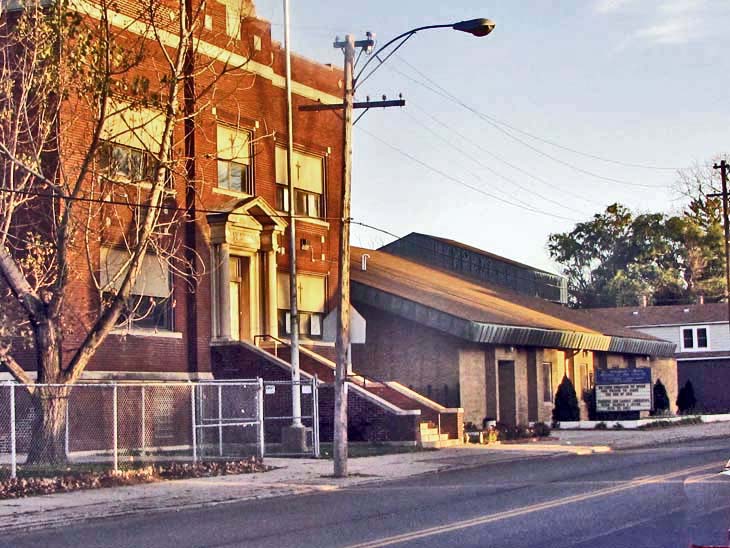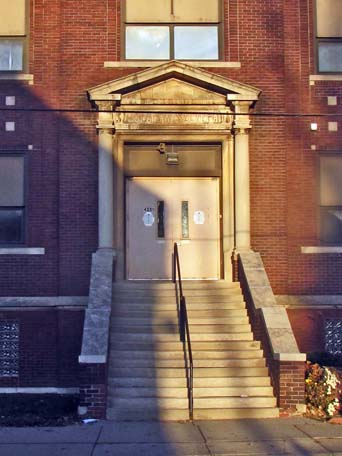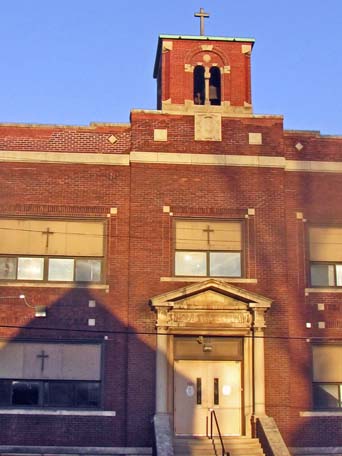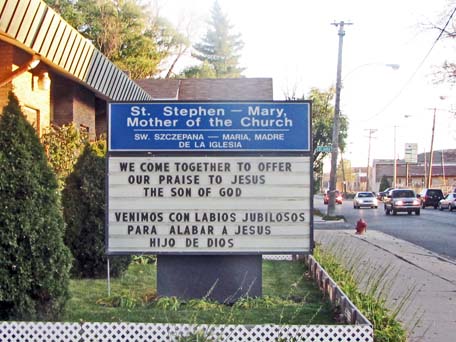

I am uninformed about the history of this parish. I infer that the Roman Catholic diocese established a parish in this area to serve a Polish population in about 1916. It was given the name St. Stephen. I believe that the building pictured here is the former St. Stephen’s parochial school. The apostles needed assistants to spread Christianity so they ordained seven deacons. Stephen is the most well-known of the early deacons. He was highly effective in his preaching about Christ. Those who opposed the new religion and Stephen’s preaching were upset. They dragged him into the Jerusalem suburban ring and stoned him to death. Thus he is regarded as the first Christian martyr. He is commemorated in the Good King Wenceslaus Christmas carol. Wenceslas. a charitable tenth-century Bohemian duke with a reputation for his charity, went out on a very cold and snowy feast of Stephen—December 26—to provide food and comfort for the poor.

The Polish population moved away from southwest Detroit after World War II, but during that War, a considerable number of Mexican-Americans and Mexicans came to Detroit to take defense industry jobs. Some remained, many of them living in southwest Detroit. The diocese established a new parish, Maria, Madre de la Iglesias, to serve the Hispanic population in about 1980. I think—but I do not know for sure—that the old St. Stephen church was razed and replaced by the low-rise structure that served the new parish. I wonder if this church is the most recently built Catholic Church within the city of Detroit?
At a nearby location, 4200 Martin, stands a very large Gothic Church built in 1952 for what was then a Polish community. This is the church for Our Lady Queen of Angeles parish. Latinos moved into the area and the name of the parish was translated to La Igelesia Catholica de Nuestra Senora Reine de Los Angeles. At the start of 2014, the former Our Lady Queen of Angeles parish was merged with the Mary, Mother of the Church parish and given the name Our Lady of Guadalupe. I believe that both the newer church here on Central and the older structure on Martin are now used as churches.

Our Lady of Guadalupe is an important symbol in Mexican Catholicism. Many believe that, on December 9, 1521, a Native American by the name of Juan Diego saw a vision of the Blessed Virgin on a hill near Mexico City in an area now known as Guadalupe. Mary spoke to him in his own tongue. Diego reported this to a skeptical Archbishop Zumarrage in Mexico City. The archbishop told Diego to return to the spot and get a confirmation from theBlessed Virgin. Diego did as he was told and once again saw the Blessed Virgin. He explained his need for proof and Mary told him to go to a nearby location and pluck flowers. This was December so flowers were typically not blooming in the higher elevations of Mexico. Diego went and found roses in bloom but they were a type of rose known in Spain but not in Mexico. Diego collected the roses and returned to see Archbishop Zumarrage. He opened his cloak to display the roses and then found that an image of the Virgin was imprinted on the cloak.
There is some recycling involved in the name of this parish. A modest number of Mexicans came to Detroit to work in defense plants during World War I. Many or most of them were more or less forcefully returned to their native land after that war. However, Bishop Gallagher realized that there were a sufficient number such that a Spanish language parish should be organized so the first Our Lady of Guadalupe parish came into existence in 1920. I believe that the parish built a church on 18th Street near Merrick in 1923. However, that parish was terminated in 1957 and, I believe, their church was razed. At that time, I think that Most Holy Redeemer on Vernor Highway at Junction was designed at the parish for Hispanic Catholics.
The Catholic diocese has closed dozens of parishes in Detroit since the 1960s as the faithful moved to the suburbs. The parishes in southwest Detroit survived because of a modest immigration of Hispanics in the years before 2000. The city’s Spanish-origin population grew to about 50,000 at that date, but has grown very slowly in the new millennium. The Hispanic population of metropolitan Detroit is increasing but at a very low rate compared to the rest of the nation. Almost all of the growth since 2000 has been in the suburbs. Demography is destiny for most religious organizations so there may be further consolidations of the southwest Detroit parishes that now serve Spanish speakers.
Founding of St. Stephen Parish: 1917
Building of St. Stephen Church: 1918
Architect: Unknown to me
Founding of Mary Mother of the Church Mission: 1981
Building of the new church: Unknown to me
Merger of St. Stephen and Mary Mother of the Church parishes: 1995
Merger of Mary Mother of the Church and Our Lady Queen of Angels Parish: 2014
Use in 2015: Active Catholic parish; I believe the former St. Stephen school is now home to a small middle school providing sixth, seventh and eighth grade instruction
City of Detroit DesignatedHistoric District: Not listed
State of Michigan Registry of Historic Sites: Not listed
National Register of Historic Places: Not listed
Photograph: Ren Farley; November 10, 2010
Description prepared: January, 2015